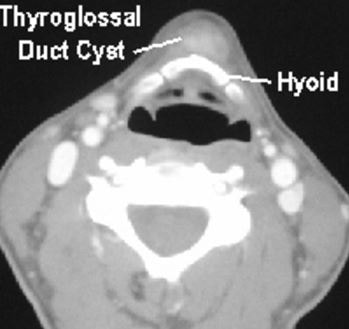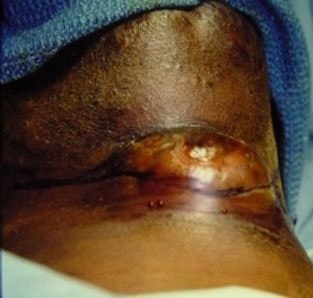Thyroglossal Duct Cyst
Overview of Thyroglossal Duct Cyst
Thyroglossal Duct Cyst is one of the most common congenital neck cysts. This is actually mass or lump formed after the formation of the Thyroid Gland. Medically, it is said that the Thyroglossal Duct Cyst is formed from the cells and tissues that remained after the formation of the gland. This takes place during the embryonic development.

However, it is not diagnosed at an early stage of life. Generally at the pre-school age, this comes into the picture sometimes due to the respiratory infection. This is most commonly found in the midline neck mass. The criticality and severity of the tissue start when it gets enlarged with time. However, infection and malignancy can increase the severity of the cyst.
Thyroglossal Duct Cyst is directly associated with the formation of the Thyroid Gland. Thyroglossal Duct is one of the ducts that remain during the formation of the gland. The Thyroid gland starts forming at the base of the tongue during the embryonic development.
However, as the gland starts forming it uses the Thyroglossal Duct to move down to the neck. When the formation gets completed, the Thyroid goes back to the neck position.
The Thyroglossal Duct generally disappears after the formation but sometimes it leaves behind some cavities and pockets in the neck. Various fluids and mucus get accumulated here and form the Thyroglossal Duct Cyst as the age grows. However, if it gets infected, then it starts growing in size.
Symptoms and Signs
The symptoms are very important to recognize any problem. It is not so different with Thyroglossal Duct Cyst as well. The signs and the symptoms generally come at the pre-school age of the children and slowly it gets dense. If you know the symptoms and the signs very well, then you can detect the disease very early and that would be an added advantage for the treatment. Here are the signs and the symptoms of the Thyroglossal Duct Cyst.
- At the center front of the neck, a round mass can be noticed. It may not be painful at first and should be felt soft at touch.
- The round mass may remain present and does not do any harm. It should not bother you for eating or breathing. However, this is only possible when your round mass is not infected.
- However, if infected the symptoms get drastically changed. Redness, tenderness and sometimes swelling can also be observed. You may also feel burning sensation and itching at the same time. The mass gets infected at inside, but redness should be visible.
- A small opening in the skin can be observed near the opening of the cyst can be noticed. The opening is present in the Thyroglossal Duct Cyst for the purpose of drainage of the mucus.
- The patient would be troubled to eat or even breathe with the cyst. The situation can become worse if not taken care properly at the early stage.
- The size of the mass tends to grow with time and severity grows with the size and the amount of infection of the cyst.
The symptoms get more prominent and clear with the time. It is best to detect the symptoms at the early stage to ensure early diagnosis and better treatment for the Thyroglossal Duct Cyst.
Diagnosis of Thyroglossal Duct Cyst
Thyroglossal Duct Cyst is a simple and not a so dangerous problem if there is no infection involved. It can contain some debris of the Thyroid Gland, but the fluid inside it may not be so dangerous. However, the cysts are very susceptible to infection and often lead to the complicated stage where heterogeneous mass gets accumulated in the pockets of the cysts and the round mass is formed.
The swelling due to infection further enhances the problem. However, detection and the severity of the symptom can be easily diagnosed with the Radiological Manifestations. The major and most common techniques for the diagnosis of the disease are following.
- Ultra Sound-The imaging technique using high frequency sound waves can be extremely helpful to understand the mass surrounded in the cyst. It can also give indication for the infection.
- CT Scan- It can also be useful to analyze and detect the presence of the cysts in the neck. The technique can establish the thickness of the wall of the smooth, the thickness of the mass and others. It helps to understand the severity of the Thyroglossal Duct Cyst.

Axial CT showing a thyroglossal duct cyst attached to the hyoid bone
- MRI Scan, Blood test, Thyroid Scan are the other techniques that can be used to diagnose the disease.
Treatment
There is no proper medicinal treatment for the disease. The cysts are congenital parts of the body that form abnormalities and cysts. The infected cysts are even more dangerous than the normal. The primary treatment for the infected Thyroglossal Duct Cyst is the surgery of the cyst.

Because the embryonic hyoid bone forms around the thyroglossal duct, it is important to remove the body of the hyoid along with the thyroglossal duct and follow it to the foramen caecum at the base of the tongue (Sistrunk procedure)
According to the doctors, the cysts and the duct can be removed from the neck up to foramen caecum successfully. However, even after the operation the duct or cysts can relapse. However, the probability is very thin and can be considered only 2%-3%.
Thyroglossal Duct Cyst may get malignant or cancerous as well, if not treated on time. So, it is always important to take care of signs and symptoms. The patient should be rushed to the doctor as soon as you realize that it could be Thyroglossal Duct Cyst.
Pictures

Infected thyroglossal duct cysts (above and right)

References
- https://www.urmc.rochester.edu/encyclopedia/content.aspx?ContentTypeID=90&ContentID=P02068
- https://en.wikipedia.org/wiki/Thyroglossal_cyst
- http://emedicine.medscape.com/article/1346365-overview
- http://radiopaedia.org/articles/thyroglossal-duct-cyst
- http://www.ncbi.nlm.nih.gov/pmc/articles/PMC2729228/
- http://www.childrenshospital.org/conditions-and-treatments/conditions/thyroglossal-duct-cyst
- http://www.aboutkidshealth.ca/en/healthaz/conditionsanddiseases/earnoseandthroatdisorders/pages/thyroglossal-duct-cyst.aspx
- http://www.ajnr.org/content/21/8/1547.full
